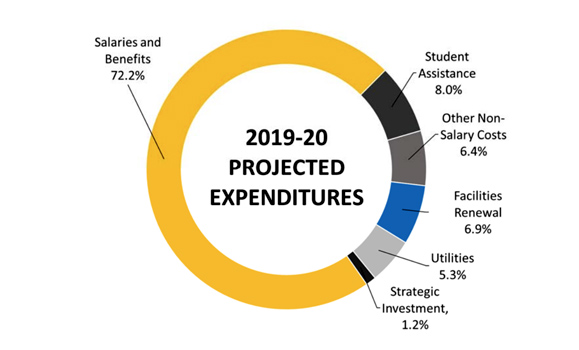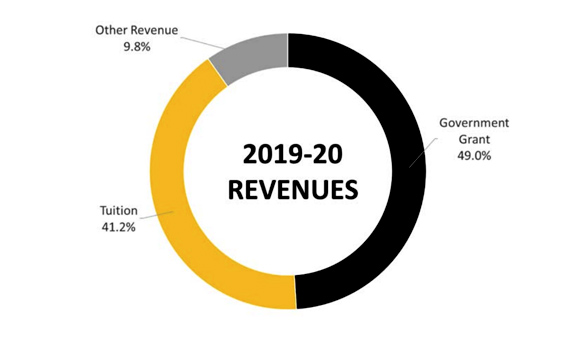╣√╜┤╩╙╞╡тАЩs Budget Advisory Committee (BAC) has released its draft plan for the 2020-21 operating budget тАФ a plan that aims to ensure financial responsibility while also advancing DalтАЩs core mission and priorities.
With revenues and expenditures balanced at $469.9M, the plan тАФ which is tentative pending further input from the university community тАФ makes new investments in priority areas identified in the BACтАЩs consultations with students, faculty and staff. These include student assistance, facilities renewal, classroom technology and the pool of funding available for strategic initiatives.
It also includes measures to address the core budget challenge ╣√╜┤╩╙╞╡ faces each year: that costs increase at a faster rate than government funding does, leaving tuition (which makes up the bulk of the remainder of the operating budget) as the primary tool available to Dal to balance the budget and fund its priorities.
Read the full budget plan and tuition recommendations: dal.ca/budget
тАЬOur success as a university requires investment in our people, our services and supports, our Faculties and facilities, and all aspects of our academic mission,тАЭ says Provost Teri Balser, who chairs the BAC. тАЬThatтАЩs what the operating budget aims to do.тАЭ
Moving DalтАЩs academic mission forward
The Budget Advisory Committee (BAC) is a group chaired by the Provost, with members of senior leadership, faculty, staff and students. The BAC leads DalтАЩs transparent and consultative budget planning process, preparing high-level recommendations for how funding should be allocated across the university. ItтАЩs then up to leadership in each Faculty or service/support unit тАФ deans, directors and AVPs тАФ to determine how best to allocate those resources to deliver on their plans and ensure DalтАЩs strategic goals are achieved.

Most of the operating budget тАФ over 72% тАФ is spent on salaries, benefits and pension payments (тАЬtotal compensationтАЭ) to faculty and staff. That leaves 28% or so of the budget (roughly $132M) to cover a wide range of other university priorities: general expenses for Faculties and service/support units, scholarships and bursaries, utility costs, facilities maintenance and classroom upgrades, IT requirements and more. And most of these costs increase each year.
Read also: Behind the budget: Revenues and expenses (Feb 21)
The BAC draft plan estimates that, including compensation, Faculty and service/support unit costs will go up by 3.9% in 2020-21. In contrast, DalтАЩs government grant, which makes up just under half of the operating budget, only increases 1% each year, as outlined in the Memorandum of Understanding (MOU) between Nova ScotiaтАЩs universities and the provincial government.
тАЬBecause resources are limited, we need to be focused, smart, and strategic in where we invest,тАЭ writes the BAC in its report. тАЬThe budget must balance, but we also need to ensure that ╣√╜┤╩╙╞╡ continues to thrive тАФ that weтАЩre supporting our students, our faculty and our staff to move our academic mission forward.тАЭ
Some of the ways the budget plan proposes to do that include:
Limiting the budget gap in Faculties and service/support units: Faculty and other service/support unit operating budgets also increase annually, and funding allocated does not fully cover increased expenditures (driven largely by compensation for faculty/staff). As recently as four years ago, Faculties and service/support units were being asked to find upwards of 2-3.5% in cost savings each year to close the gap between rising costs and available resources. The BAC has made minimizing this gap a priority. This year, the gap is only 0.5% тАФ meaning more resources stay with Deans and other academic leaders to address FacultiesтАЩ needs. (In total, 63.2% of DalтАЩs operating expenditures are spent in DalтАЩs Faculties, including Graduate Studies and Continuing Education.)
Student assistance: ╣√╜┤╩╙╞╡ spends more than $70M each year on student assistance. A large chunk of that ($49M) comes from the operating budget, and this yearтАЩs plan increases that amount by $455,000, with a focus on international students and designated groups.
Facilities and IT infrastructure: DalтАЩs 162 buildings and utility distribution facilities have more than $500M in whatтАЩs called тАЬdeferred maintenanceтАЭ тАФ required maintenance thatтАЩs currently or past due. To keep advancing this important work on DalтАЩs classroom, research and working spaces, the budget plan increases facilities renewal spending by $4M ($3M of which can only be used if enrolment targets are met). This will be in addition to the one-time allocation of funding from the provincial government this year. The budget plan also increases classroom audiovisual technology spending by $500,000 and adds $600,000 in IT network capacity and infrastructure requirements. ╠¤
Strategic funding: Each year Dal puts resources aside to address emerging areas of importance тАФ particularly key this year, given a new strategic plan is in development. Priorities for investment cited in the BAC report include equity, diversity and inclusion initiatives; student support; online and digital delivery of programs; and rejuvenating DalтАЩs website. The budget plan allocates $9M overall in strategic investments and initiatives ($3M of which will only be provided if enrolment targets are met).
Making tuition more predictable
Addressing rising costs and investing in university priorities requires resources. With costs increasing at a faster rate than government funding, that leaves tuition тАФ which funds 43% of the operating budget тАФ as the only significant means available to balance the operating budget. Under DalтАЩs current funding model, it is clear the university will need to continue increasing general tuition annually to ensure a balanced budget that enables ╣√╜┤╩╙╞╡'s success.

ThatтАЩs why the Budget Advisory Committee is recommending a 3% general increase to tuition in 2020-21, and also in the subsequent two years. This is in line with recent budgets: general tuition has gone up by 3% each year since 2011-12. While the BAC has not traditionally made multi-year recommendations for general tuition fees, itтАЩs doing so this year for a number of reasons, though largely because of the certainty provided by the current provincial MOU and also to help make things clearer for students.
тАЬWeтАЩve heard feedback from students that they want to be better able to plan for paying their fees, and for increases to be more predictable,тАЭ says Provost Balser. тАЬCommitting to these increases now sets clearer expectations going forward, allowing students to prepare for and plan their expected expenses during the course of their degree.тАЭ
More on tuition and the draft budget plan: dal.ca/budget
The budget plan also continues the four-year, phased-in increases to international tuition that were approved by the Board of Governors last April. The additional increases of $1,473 annually (on top of general fee increases) for students beginning their programs in Sept. 2019 and later are meant to bring DalтАЩs international fees closer to its comparator universities across Canada. Even with these increases, DalтАЩs international fees remain well below average.
Those increases came with a commitment to review and invest in international students on campus. Following last yearтАЩs decision, a Rapid Task Force recommended new investments in international services and supports, now underway or in progress. These include: a program manager for international student support; a Mandarin-speaking international student advisor; an additional writing centre advisor; and further new supports for writing, advising, and intercultural competence.
The university will also continue to monitor the impacts of these fee changes, though this year DalтАЩs international enrolment did grow by 501 studentsтАФ a 12% increase.
How to learn more
Want to learn more about the draft budget plan?
In addition to visiting dal.ca/budget and reading the plan in full, members of the Dal community can attend an upcoming Campus Budget Sessions, featuring a presentation on the operating budget and Q&A.
╠¤
Wednesday, March 4
Room 430, Jacob Slonim Boardroom, Goldberg Computer Science Building
12:30-1:30 p.m. (live video stream will be available at dal.ca/budget). Questions can be submitted ahead of time to BAC@dal.ca.
The Budget Advisory Committee will also present its recommendations to students on March 4 from 6-7 p.m., in Room 224, Student Union Building and to the ╣√╜┤╩╙╞╡ Senate at its March 9 meeting (3-5 p.m., Theatre A, Tupper Building).
Comments on the draft budget plan can be forwarded to the Committee by email at BAC@dal.ca. Feedback received before March 18 will be reviewed by the BAC before the final budget plan is released.
A final version of the budget plan, incorporating feedback, will be circulated in late March. Tuition and fee recommendations will go before the Board of Governors for approval in April, with the final operating budget going before the Board for approval in June.
More info: dal.ca/budget

